25 Types Of Blog Posts That Get Engagement (With Examples)
Do you want to get more traffic and engagement? Then you’ll have to experiment with different types of blog posts.
You see:
It’s not enough that you publish blog content. You also need to know what blog posts work best for your target audience.
So when coming up with blog post ideas, go ahead and introduce new formats. This will help you learn what sort of content your readers want and expect from you.
Below are 25 blog post types that you can try.
Reviews
Reviews are always popular and do generate a lot of engagement. When people want information on a product or service, the first thing they do is look up reviews.
And while there are a lot of video blogs out there, some still prefer written reviews because they make it easier to process information like product specifications.
They work for both physical and digital products.
It’s not that hard to create reviews since most of them follow a template. However, you do need access to the product or service you’re going to review to make it comprehensive. And that can be a challenge, especially for new bloggers.
Product roundup
When people are in the market for a type of product, they want to look at all their options. Product roundups offer them a way to conveniently do so.
All the information a user might need is on one page. Not only do they get to see a summary of the best products in a category, but they’re also provided details like pricing as well as pros and cons.
How to present all that information is in the hands of the content marketing team.
Here’s an example of a product roundup. It’s a list of the best overdrive pedals from Tone Island.
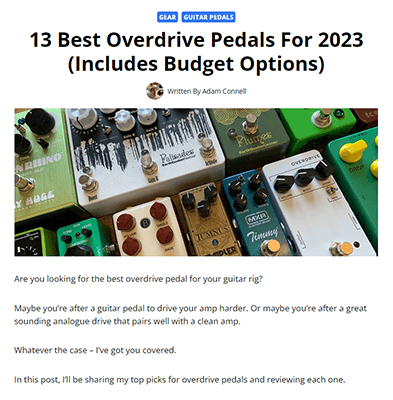
Unlike reviews, product roundups are easier to write since most of them only contain basic information. You can, of course, add your personal thoughts on products — especially if you have first-hand experience using them.
Data-driven posts
While your typical data-driven posts might not be popular with the average internet user, they’re extremely useful for researchers, marketers, students, industry leaders, scientists, and even business owners.
And if you manage to publish a substantial post about a certain topic, your community will use it as a resource for their own posts. That means getting backlinks from high-quality sites and shares on social media.
Here’s an example of a data-driven post — a collection of statistics about affiliate marketing.
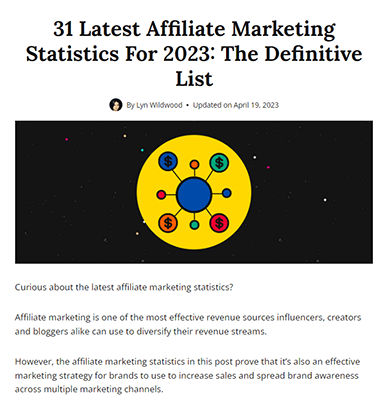
The main challenge with this type of post is finding reliable information online.
Everything you publish needs to be factual and as current as possible. That means you need to double-check all the statements you make. This can be a time-consuming process that not all bloggers are comfortable with.
Listicles
Lists are highly engaging because they’re so digestible. Anyone who doesn’t have the time to read through an entire post can scroll through an article and still get most of the information they need.
These posts don’t need complex topics either. Meaning they don’t require as much research especially if you’re already an expert on the topic.
You can also easily convert listicles into content for your other marketing channels like social media.
Here’s an example of a simple listicle from Tone Island.

Another advantage of listicles is that you can publish one regardless of what industry you’re in. It’s very flexible in that sense.
The more entries you have on your list, the more value it seems to have for users. That’s why lists with more entries tend to get more clicks on Google search results.
How-to guides
How-to guides are a staple on the internet. Do a quick search and you’ll almost find a how-to article for just about any topic.
These blog posts get users unstuck from whatever predicament they find themselves in. If you include how-to posts in your content marketing strategy, you can become the go-to resource in your category.
Here’s an example how-to post about how to start a blog from Blogging Wizard.
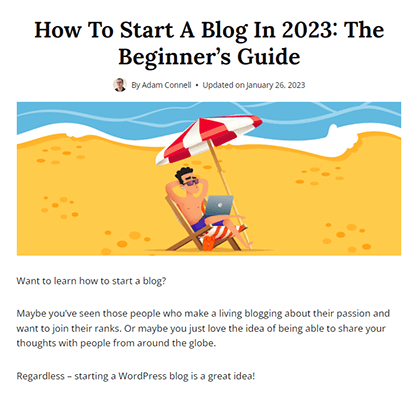
Write enough posts about a particular topic and you could end up being an industry expert which will give you credibility in the space.
Depending on the topic, how-to blogs also tend to become evergreen content. These are posts that remain relevant long after it’s published. At the very least, you can update them so that they continue to remain relevant.
Beginner’s guides
Beginner’s guides work almost the same way as how-to guides. The only difference is that you’re speaking directly to an audience that has little to no experience with the topic at hand.
This means you’ll have to write in such a way that the reader won’t get intimidated or overwhelmed.
Here’s an example from Your Creative Aura for those that want to see what a beginner’s guide looks like.
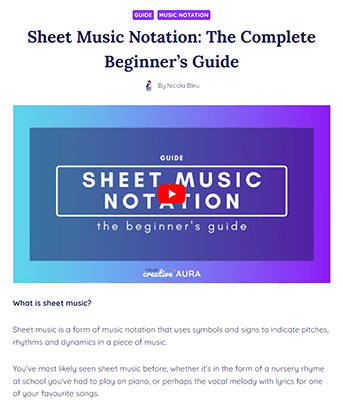
The tone you use when writing beginner’s guides is important. You should sound more like a friend guiding the reader through the necessary steps needed to accomplish a goal.
The nice thing about this type of blog post is that people actively seek them out. Finding the right topic can be a challenge though. And if you write a lot of beginner’s guides in your category, finding new topics will gradually become more difficult.
Case studies
If you’re an entrepreneur and you’re willing to release data about the business, you can publish case studies. These are wildly popular with industry experts that want to know all the latest trends and best practices.
Case studies work like this:
You detail the problem you’re trying to solve, show what steps you’re going to take to solve those problems, walk readers through the execution, and post the outcome.
Here’s an example from PowerLease.
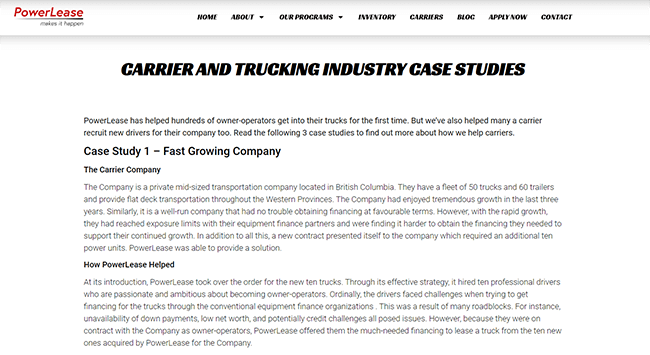
Case studies aren’t anything like personal blogs. You’re encouraged to sound like an expert in your field. It’s your chance to show how competent you are as a business owner.
Most companies use case studies to not only generate traffic for their sites but to also advertise their services.
Comparison posts
Comparison posts are exactly as they sound. Bloggers take two similar products and compare them. The goal is to help readers make the distinction so that they can make informed decisions when it’s time to make a purchase.
Depending on the products you’re comparing, you might not need access to them. What you do need is information. You can make comparisons based on specs released by the manufacturer, for example.
Here’s a comparison post about the Jordan 1 and Air Force 1.
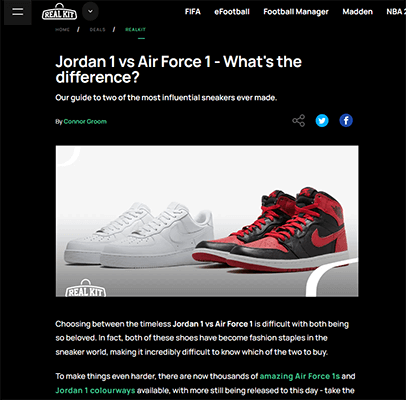
And you don’t have to review third-party products at all.
If you have products of your own, you can use comparison posts to help your customers tell the differences and similarities between them.
Opinions
Opinion blogs are arguably the easiest type of posts to publish. You only need to share your thoughts on a subject. It’s much more forgiving than blog types that require a tremendous amount of research.
But there are downsides to publishing opinions.
Since you’re sharing your personal thoughts, you can get backlash for hot takes on a topic or controversial statements you make.
But if you’re the type that can take the heat, then you’ll probably be fine. Unlike Twitter posts, you can turn off comments if it becomes too much.
Here’s an example of an opinion post from Cal Newport.
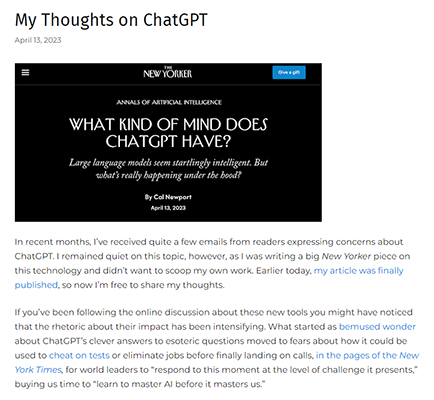
Opinion posts can be about anything though you should do your best to keep them consistent with your site’s niche.
Interviews
Those that have access to influential people in your industry should consider publishing interviews. And you don’t even need to get big names, especially if you’re just starting.
For instance, you can interview people with news blogs, fashion blogs, food blogs, or people that just like publishing funny posts.
As long as they’re relevant to your core audience, there’s no reason why an interview wouldn’t work.
Here’s a great example of a blogger interview.
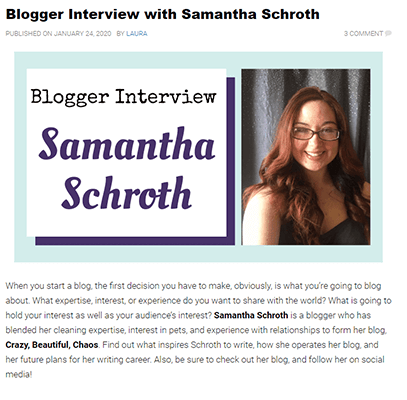
Interviews are great for bloggers because you’re providing readers with data that they wouldn’t get anywhere else. They’re going to get information straight from the source.
From a writing perspective, these can be easier to produce because the majority of the post would be a transcription of the interview. You don’t have to write as much.
News posts
While news outlets do struggle with generating funds to keep their lights on, there are still plenty of news blogs out there that perform reasonably well.
This is because people like to see how people react to certain news stories. They like to get a pulse on what others think.
Here’s an example of a news post from TechCrunch.
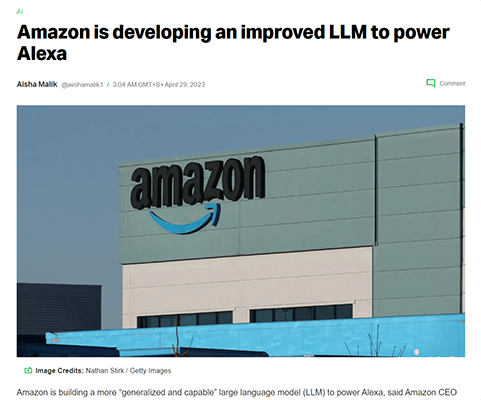
Reacting to news posts tends to generate engagement because readers like to share their own opinions. The problem is that once the story gets old, your posts won’t get as much traffic as they used to.
You’ll have to continue publishing news posts to sustain momentum. The upside, however, is that there’s always going to be something to talk about.
Infographic post
Infographics get people to take in a ton of information while keeping their attention. They do so by presenting data in a visually pleasing format.
Here’s what an infographic blog looks like:
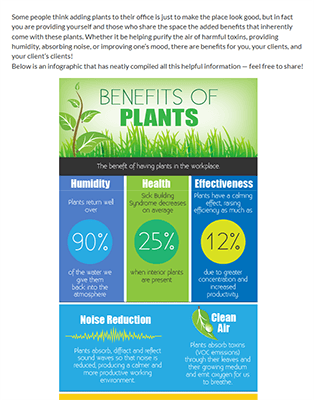
There are tools on the internet that you can use to create an infographic — even if you don’t have any graphic design experience. So there’s no reason why you shouldn’t give it a try.
A lot of readers share infographics through their own blogs or on social media. So there’s a good chance that your infographic could make its way through those platforms.
If you have a graphic designer on your team, you can make infographic designs that exceed what the average template has to offer. Those that plan on releasing multiple infographics should look into hiring a designer (even a freelancer would do) if they don’t have one already.
Guest posts
Are you having trouble publishing content on your site? Don’t have the time or resources to publish consistently? Then why don’t you try publishing guest posts?
Guest posts are content written by authors that aren’t associated with your site. They’re willing to provide free content in exchange for a backlink or having their name in the author bio section.
Here’s a guest post that includes the author’s name in the bio along with a backlink to a skincare brand:
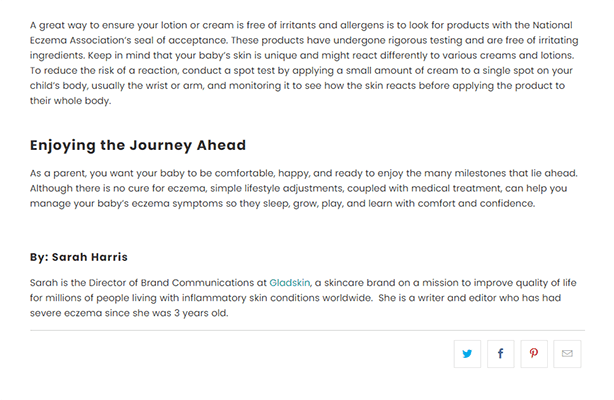
If you get a popular guest blogger to write a post, there’s a chance that your blog can get some good exposure.
Resource posts
Resource posts collate different tools that a person might need to accomplish a task. They’re highly sought after for the same reason as product roundups. These posts collate everything readers will need in one place.
Here’s what a resource post looks like:
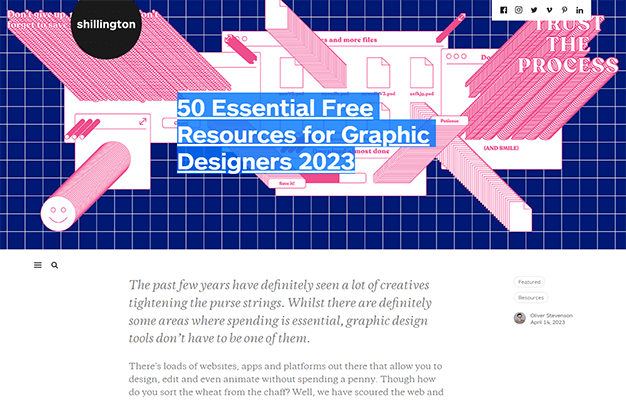
These posts are research-intensive. Recommending faulty tools and products could make you lose credibility. And if you’re an affiliate marketer, you will have to disclose it or else you might get into trouble.
But if done right, resource posts can lead to reader engagement. Other blogs publish this type of post because people keep coming back. Some visitors even bookmark them for use later.
Instructional blogs
Instructional blogs share similarities with how-to blogs. The difference is in the intent. How-to blogs show people how to perform a task. Instructional blogs tell people how to use a product or service.
Here’s an instructional blog on how to use a fire extinguisher:
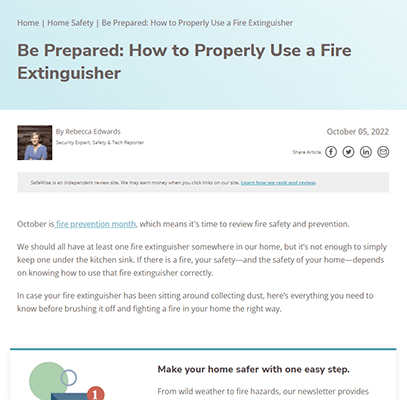
You can write an instructional blog for your products. What’s great about this strategy is you’re attracting new users to your site while providing existing customers with reference materials.
It can even be a form of marketing for some business owners.
Sellers of electronics, for example, can write instructional blogs as an added service for their customers.
Reflections
A reflection post looks and feels more like a personal blog. These aren’t that different from opinion posts. But with reflections, you can connect with readers on a deeper, more personal level.
Here’s what a typical reflection blog looks like:

With opinion posts, you still have to keep the business or brand in mind while writing. And you need to choose topics that are relevant to your audience.
Reflections can still be about your business but readers won’t mind if you suddenly go off topic. These posts are more about you, the author, than the site you represent. You can tell personal stories if that’s what you want to do.
The only problem is that you do need to establish yourself first for people to care about what you have to say.
Predictions
Prediction blog posts are a good way of gaining new interest in a topic that’s on the verge of dying. For example, people hate talking about Twitter and the drama around it already. But making a Twitter prediction post could inspire people to jump back into the discussion.

Your content team can also use predictions to drum up interest in your company by posting about where it’s headed.
But you should exercise caution. You could end up posting controversial articles that could lead to heated exchanges online. Your credibility could also take a hit if none of your predictions end up coming to fruition.
Year-end recap
Just before the new year rolls in, you can publish a year-end recap that highlights what you were able to accomplish in the last 365 days.
Whether you’re running a business or a personal blogger, you can summarize the year that was and share everything you’ve learned so far.
Here’s an example of a year-end recap post:
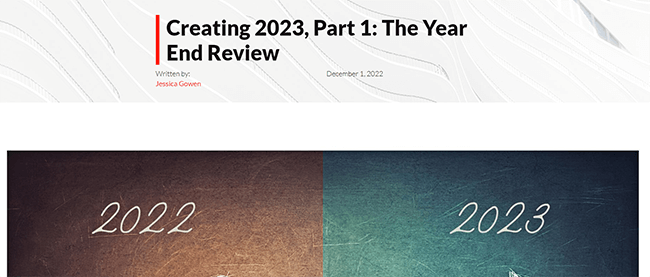
Everybody can publish one. Even someone with a photography blog can tell stories about the best photos taken that year.
While you can’t publish many of these, you can pack each one with so much useful information that your readers will look forward to reading them every year.
Seasonal posts
You can also create posts based on an upcoming season. Your content can center around Christmas when that time of the year is just around the corner. Or you can publish Valentine’s Day posts around February like this one:

As to what type of posts, it will all depend on you. It could be a simple fun post reminding people that the holiday is fast approaching. Or you can do a list post that features some of the products you offer.
Gift ideas are especially popular around any holiday. You might want to take advantage.
Behind the scenes
People want to see what goes on behind the scenes. That is true for movies, businesses, TV shows, events, and concerts.
If you have anything to share that you think your audience would like to see, you can make behind-the-scenes blog posts.
Here’s what that looks like in practice:
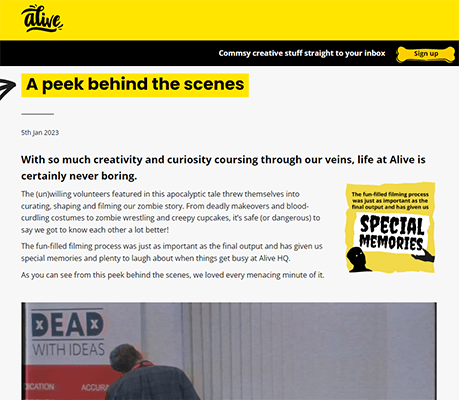
This type of blog post will need to include photos and videos. Telling the story in words can work but it won’t be as captivating.
You want people to feel like they were there.
Behind-the-scenes posts humanize you and your business. And it introduces readers to people that don’t get as much recognition. It also educates them on the hard work necessary to make things happen.
Explainer
An explainer blog is where you take a complex topic and break it down so that readers can understand it better. Its main goal is to educate.
The medical field is ripe with explainer blogs because most patients can’t comprehend medical jargon. They want to understand subjects like perioral rejuvenation through everyday language.

It would be better if you include a video in your explainer blog post to convey your message more efficiently.
You will need to have extensive knowledge about the subject matter if you want to create new blog posts though. You don’t want to spread misinformation, especially if the topic revolves around complex issues like healthcare.
Contests
Using a blog post as a platform for announcing contests is just what most companies do. You can then share the link to the post on your social media platforms.
Since you can make a post as long as you want, you can include as many details as you need to without losing a reader’s attention. This isn’t something encouraged on social media.
This car costume contest uses a blog post to share its mechanics and prizes:
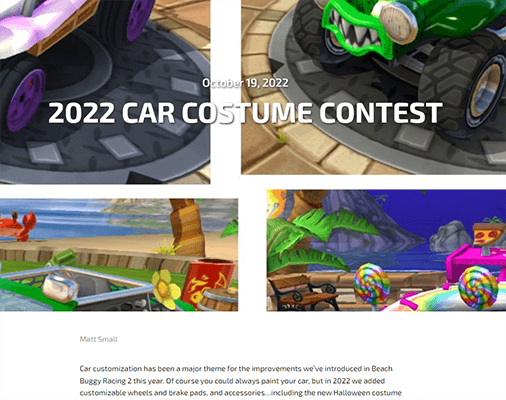
The good news is that contests are extremely easy to create, even if you don’t have any funds. If you have connections with any brands, now is the time to use them. Reach out to your contacts and see if they’d be willing to donate a prize.
In return, they’ll get exposure to your audience and the mechanics of the giveaway can be configured to ensure they can get new social media followers and email subscribers.
All you need is a contest tool such as SweepWidget that will allow you to set specific entry methods for the giveaway. For example, you could choose entry methods such as subscribing to your email list, subscribing to your YouTube channel, etc. Add extra methods to support the brand that will be providing the prize.
The tool will also help you select a winner as well.
Related Reading: 200+ Best Giveaway Prize Ideas For Your Next Contest.
Success stories
Businesses like publishing success stories. Not only do they help build a working relationship with customers, but they also make for great advertising.
Customers will share posts that feature their company with their own followers. That’s free publicity for you. And it doesn’t take that much to write up their story. You can just email them directly and see if they’re willing to participate.
Here’s a success story example about a Fixer Collective:
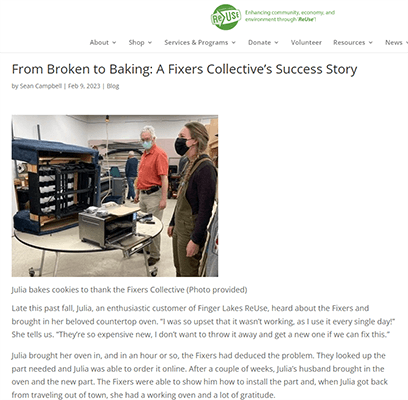
Success stories also serve as social proof. Meaning they prove that you do have customers and that they’re happy with what you bring to the table.
Travel
Posts about traveling to places are always popular and engaging. If you’re a well-traveled person and you managed to save photos and videos from your trip, why not write about your adventures?
You can write a travel blog in so many ways. You can narrate the story from start to finish. Or you can share your itinerary to show people how you spent your time. Some bloggers do financial breakdowns to give people an idea of how much they’ll spend if they want to replicate your trip.

Some written posts combine all of that.
Feel free to experiment with how you write your posts. Find one that will best suit your audience.
Product announcements
Yes, you can write blog posts about upcoming products. Not only does this hype up the launch, but it also gives people a chance to see what your new product can do for them.
Some companies also use announcement posts to garner interest for an upcoming feature or upgrade.
Brands like Sony do this all the time:

You want to provide as much information as you can. And don’t forget to include the launch date if you’re able to disclose it.
Some companies even publish teaser blog posts to get people talking way before the actual announcement. You can go that route if you want.
Final thoughts
There we have it, 25 different types of posts you can create for your blog.
Creating content your readers will love is what will enable your blog to thrive. Focusing on the same style of post can drive away recurring engagement especially if it drives focus away from your blog’s main purpose.
If your blog is about maintaining your garden all year round, show them how this is achieved. Don’t focus solely on product recommendations, add some variety.
So the next time you’re feeling stuck in a rut, don’t worry we’ve got you covered.

